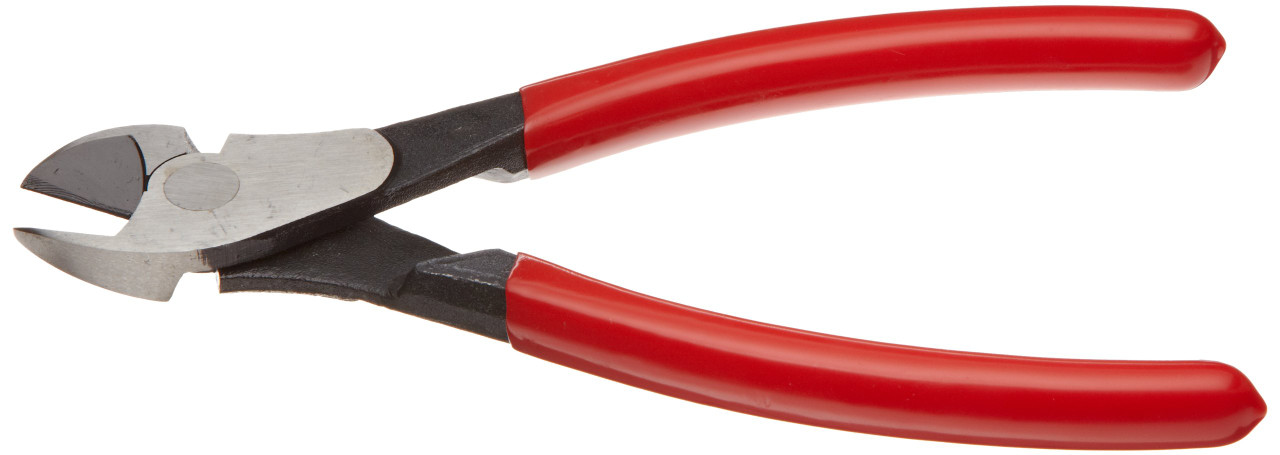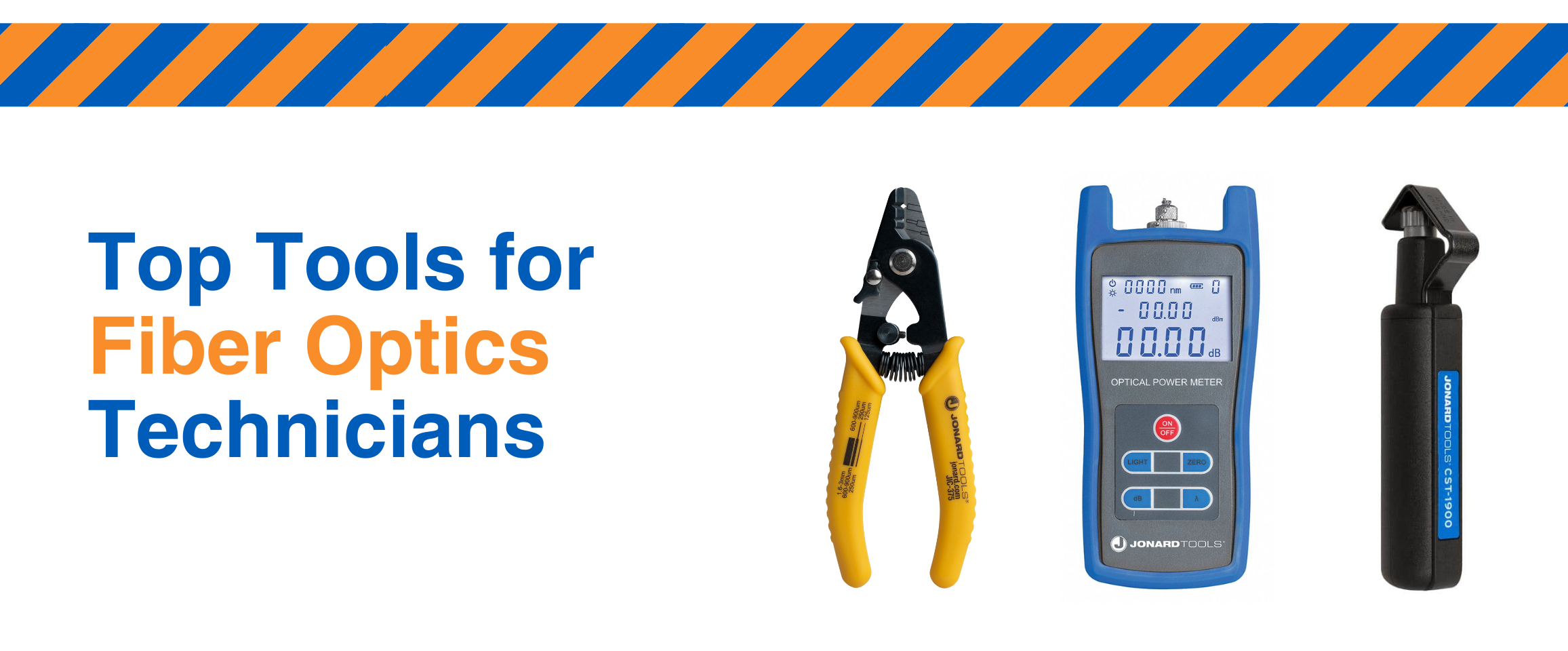Top 7 Must-Have Tools for Fiber Optic Technicians
The deployment of Fiber Optics Technology is advancing at a rapid pace. With the ability to transmit data at high speeds and the ever increasing bandwidth needs, Fiber Optics help to meet industry and consumer demands. With this exponential rise in Fiber Optics, the demand for fiber optic technicians has also increased. According to the Bureau of Labor Statistics, the predicted fiber optic technician growth rate is 8%, signifying thousands of job openings in the years to come. With that being said, familiarizing yourself with important fiber optic tools is the first (and probably most important) step in becoming a technician. For that reason, Jonard Tools has identified some important fiber optic tools for technicians to ensure that you have the necessary knowledge to upstart your career!
1. Fiber Optic Stripper

A Fiber Optic Stripper is a specialized tool used to remove the protective coatings and buffer materials from optical fibers without causing damage to the delicate glass core. It has blades that allow technicians to precisely strip off the protective layers without cutting into the fiber itself. This is crucial because any damage to the fiber can result in potential issues with the fiber, such as cracks or breaks.
The importance of a fiber optic stripper lies in its role in preparing the fiber for termination or splicing. Stripping the fiber accurately ensures that the clean and undamaged glass fiber is exposed, providing a clear and consistent surface for making connections. Properly stripped fibers lead to more reliable connections, ensuring efficient signal transmission in the fiber optic network.
Using a fiber optic stripper also reduces the risk of injuries for technicians. When working with sharp blades and tiny fibers, precision and control are essential to avoid accidental cuts. The tool's design allows for safe and controlled stripping of the fibers, protecting both the fiber and the technician.
In addition to our reliable Fiber Optic Stripper , it’s essential to always include a kevlar cutter to allow you to seamlessly cut the pesky kevlar that gets in the way. Luckily, our Kevlar Cutter allows for a smooth and easy cut, allowing you full access to the fibers! These two tools are absolutely essential for fiber optic technicians to adequately interact with fiber.
2. Fiber Optic Technician Testing Tools
A. Fiber Optic Power Meter w/ Light Source

A Fiber Optic Power Meter is a handheld device used to measure the optical power in a fiber optic link. It plays a crucial role in the installation, maintenance, and troubleshooting of fiber optic networks.
The power meter measures the output power from an optical light source to the end of a fiber optic link, helping technicians verify signal strength, test for losses, and assess the overall performance of the network. By accurately measuring optical power levels, the fiber optic power meter ensures that the network is operating within specified power budgets, preventing signal degradation or loss of data transmission.
During installation, the power meter assists technicians in verifying that each connection and splice is correctly aligned and that the loss is within acceptable limits, ensuring optimal network performance. In maintenance and troubleshooting scenarios, the power meter helps identify faulty components or faulty connections, allowing technicians to pinpoint the source of signal loss and rectify it promptly.
Regular use of a fiber optic power meter is essential to maintain the reliability and efficiency of fiber optic networks, as it ensures that the signal levels remain stable and meet industry standards.
It also aids in documenting and validating network performance, providing valuable data for network audits and quality control. Check out our kit for everything you need to measure power!
B. Visual Fault Locator

A Visual Fault Locator (VFL) is a compact, pen-shaped device used by fiber optics technicians to locate and identify faults or breaks in fiber optic cables. The VFL emits a visible red laser light into the fiber, which makes it easy to detect faults such as bends, cracks, or breaks in the cable.
The VFL is an essential tool for quick and efficient troubleshooting in fiber optic networks. Its visible light allows technicians to visually inspect the entire length of the fiber, identifying the exact location of the fault without the need for complex testing equipment. When a fiber optic link experiences signal loss or connectivity issues, the VFL can help locate the fault's precise position, reducing the time needed for diagnosis and repair. Using a VFL is particularly valuable in identifying macro-bends or micro-bends in fiber optic cables, which may occur due to improper cable handling or installation. Additionally, in high-density cabling environments, such as data centers or telecommunications facilities, the VFL aids in pinpointing faults in densely packed fiber optic connections.
Overall, the visual fault locator plays a crucial role in maintaining the integrity and reliability of fiber optic networks. By rapidly identifying faults and ensuring efficient troubleshooting, the VFL helps minimize downtime, improve network performance, and reduce overall maintenance costs.
3. Buffer Tube Slitter

A Buffer Tube Slitter is an essential tool used for accessing and working with individual optical fibers within protective buffer tubes. In fiber optic cables, multiple optical fibers are often bundled together within buffer tubes, which provide mechanical protection and isolation from external factors like moisture and physical stress. The buffer tube slitter is designed to carefully and precisely cut through these protective tubes, allowing technicians to access and work on the individual fibers inside.
The process of using a buffer tube slitter involves first identifying the specific buffer tube that needs to be accessed. This tube is typically color-coded or labeled for easy identification. The slitter tool is then positioned along the length of the buffer tube, and its blade is inserted between the tube and the fibers within. By gently pulling the slitter along the tube's length, the blade creates a controlled cut that doesn't damage the enclosed fibers. This action exposes the optical fibers without harming them, enabling technicians to splice, connect, or terminate the fibers as needed.
Buffer tube slitters are crucial in fiber optic installations, maintenance, and repairs. They allow technicians to efficiently work on the individual fibers within a cable without compromising their performance or structural integrity. Proper use of a buffer tube slitter ensures that the delicate optical fibers remain intact and undamaged, enabling the transmission of data or signals at high speeds and with minimal signal loss.
4. Diagonal Cutter

A diagonal cutting plier is a specialized cutting tool designed for precisely cutting various types of cables, including fiber optic cables. Also known as cutters or dykes, these tools are crafted with precision-ground blades that allow for clean, accurate cuts without causing damage or signal loss to the delicate optical fibers. The diagonal cutter features a diagonal or angled cutting edge, enabling it to easily access and cut fibers at various angles and positions within a cable.
When working with fiber optic cables, technicians often need to access and trim optical fibers for splicing, connecting, or terminating purposes. The diagonal cutter's sharp and precise blades ensure that the fibers are cut cleanly without any risk of crushing or fracturing, which is crucial for maintaining the fiber's performance and signal integrity. These tools are especially vital in ensuring the accuracy and reliability of high-speed data transmission over optical networks.
When using a fiber optic diagonal cutter, technicians should take care to position the tool correctly and apply even pressure to achieve a clean cut. Adherence to proper techniques helps prevent unnecessary damage to the optical fibers and ensures that the network's performance remains optimal.
5. Jacket Remover

A Jacket Remover is a specialized tool used to strip the protective outer jacket from a cable. Fiber optic cables consist of multiple layers, with the outer jacket serving as a protective covering that shields the inner components, including the optical fibers and strength members, from environmental factors such as moisture, abrasion, and physical stress. A jacket remover is designed to cleanly and efficiently remove this outer layer without damaging the delicate fibers within.
The process of using a jacket remover involves positioning the tool over the section of the cable where the jacket needs to be stripped. The tool typically consists of blades or cutting elements that make a controlled circumferential cut around the jacket without affecting the underlying components. Once the cut is made, the technician can peel off the jacket to expose the optical fibers and other layers within the cable.
Jacket removers are essential tools in fiber optic installations, maintenance, and repairs. Proper use of a jacket remover ensures that the optical fibers are not accidentally damaged during the jacket removal process, which is critical for maintaining the quality and reliability of data transmission over fiber optic networks.
6. Connector Cleaners

A Fiber Connector Cleaner is a tool designed to clean the end faces of fiber optic connectors. These connectors, which are crucial for establishing precise connections between optical systems, can become contaminated with dirt, dust, oils, or other particles. Even microscopic contaminants can cause signal loss, insertion loss, or reflectance issues, affecting the overall performance of fiber optic systems. A connector cleaner is specifically developed to effectively and safely remove these contaminants from connector end faces.
Connector cleaners typically employ cleaning tips or pads that are specifically designed to match the shape and size of fiber optic connectors. By using a connector cleaner, technicians can gently wipe the end faces of connectors, removing debris and ensuring that the connector interfaces remain clean and efficient. This is especially important in high-speed data transmission, where signal quality is paramount.
Connector cleaners are used to prevent signal degradation and maintain the reliability of fiber optic networks. Clean connectors enable optimal light transmission and minimize signal loss, resulting in improved data throughput and reduced downtime. Regular cleaning with a proper connector cleaner is a fundamental practice in fiber optic maintenance, ensuring that the network operates at its peak performance level and minimizing the need for costly repairs or replacements.
Final Takeaways
Learning how to properly use these tools is critical for a promising career as a Fiber Optic Technician. These tools all play a huge role in securing the integrity of a fiber optic cable to ensure optimal connectivity. As the global leader in fiber optics, Jonard is here to help you incorporate the best tools for the most seamless and comfortable experience. In addition to the tools discussed, Jonard offers a variety of other fiber optic tools that provide the best experience for Fiber Optic Technicians. Together, we can pave the way for technicians and continue to push the industry forward!

Comments
Login or Register to post comments.